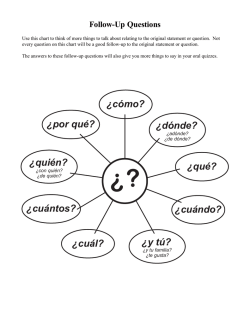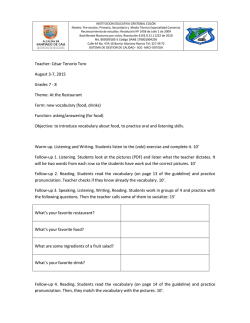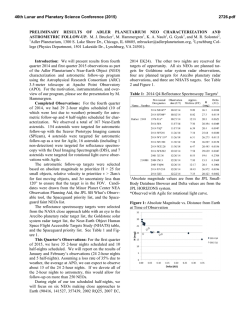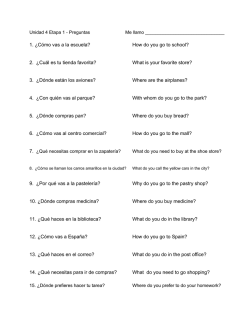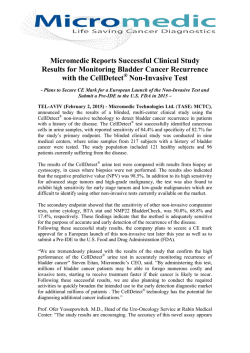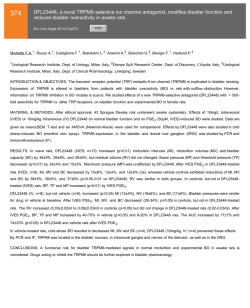
1-s2.0-S1569905614604607-main
466 Intravesical instillation of sodium hyaluronate–chondroitin sulfate in patients with Bacillus Calmette-Guérin-induced chemical cystitis unresponsive to conventional therapies: Preliminary experience with 1 year follow-up Eur Urol Suppl 2014;13;e466 Print! Print! Imperatore V. 1 , Creta M. 1 , Di Meo S. 1 , Buonopane R.1 , Fusco F.2 , Imbimbo C.2 , Longo N.2 , Mirone V. 2 1 Buon Consiglio Fatebenefratelli Hospital, Dept. of Urology, Naples, Italy, 2 University Federico II of Naples, Dept. of Urology, Naples, Italy INTRODUCTION & OBJECTIVES: Bacillus Calmette-Guérin (BCG)-induced chemical cystitis unresponsive to conventional therapies represents a therapeutic challenge. Histologically, it is characterized by an intense inflammatory reaction involving the lamina propria associated with non specific reactive atypia of the overlying urothelium that may be partially or entirely denuded. The balanced association of sodium hyaluronate - chondroitin sulfate (SH-CS) is indicated to treat chronic inflammatory diseases of the bladder originated from damage of the glycosaminoglycan layer of the urothelium. The aim of the present study was to present our experience with treatment of BCG-induced chemical cystitis unresponsive to traditional treatments with intravesical administration of SH-CS combination. MATERIAL & METHODS: We retrospectively reviewed the charts of patients with BCG-induced grade 2 chemical cystitis who had failed conventional therapies performed for at least 2 months according to the International Bladder Cancer Group recommendations and who underwent intravescical instillations of SH-CS combination. Grade 2 chemical cystitis was defined as severe and/or > 48 hours cystitis according to the World Health Organization grading scale. Patients with active urinary tract infections, follow-up < 1 year or incoplete data were excluded from the analysis. Baseline data were collected including demographics, visual analogue scale score (VAS) (1-10) for bladder pain and urgency, functional bladder capacity and daytime urinary frequency through 3-day frequency/volume charts. Follow-up data collected at 8 weeks, 6 months and 1 year intervals by means of 3-day voiding diary and VAS scores for patient-reported measures of urinary urgency and pain were also recorded together with adverse events. RESULTS: A total of 20 patients (9 males and 11 females) were identified who met study criteria. Chemical cystitis arose after a mean of 3 BCG instillations (range: 1-5). First-line therapy for cystitis consisted of quinolone antibiotics and anti-inflammatory agents in all cases. All patients suspended BCG instillations and received intravescical instillations (40 mL) of SH 1.6% and CS 2.0% in 0.9% saline once weekly for 8 weeks. All patients tolerated the treatment well. Baseline and follow-up data are depicted in Table 1. All outcome measures significantly improved at the end of the treatment. Improvements persisted over time. Not significant differences emerged between values recorded at 8 weeks, 6 months and 1 year follow-up. We did not observed any side effect due to the treatment. Table 1: Outcomes measures recorded before treatment and at follow-up evaluations Baseline 8 weeks follow-up 6 months follow-up 1 year follow-up VAS score for pain, mean (range) 7.2 (6-8) 4.2 (3-7)* 4.4 (2-7)* 4.2 (2-6)* VAS score for urgency, mean (range) 7.8 (7-9) 4.7 (3-7)* 4.5 (3-8)* 4.3 (2-5)* Voids/24 hours n, mean (range) 15.4 (12-18) 9.6 (8-13) * 9.1 (7-12)* 9.0 (7-11)* Urine volume per void mL, mean (range) 85.8 (25-150) 194.1 (80-300)* 210.9 (80-300)* 220.7 (90-310)* *: p<0.05 with respect to baseline values CONCLUSIONS: Intravesical instillation of SH-CS combination is an efficacious strategy for refractory BCG-induced chemical cystitis with durable results.
© Copyright 2026
